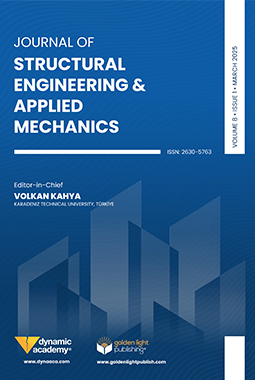ISSN:2630-5763
Journal of Structural Engineering & Applied Mechanics
ARTICLES
Zeynep Fırat Alemdar
Gözde Çakat
One of the biggest threats for structures built from past to nowadays in Turkey is earthquake. The concept of seismic isolation has been developed in order to keep the structures safe from the effects of the earthquake. Based on the idea of reducing earthquake loads acting on the structures, seismic isolation design is the most effective design technology to transfer earthquake loads to the structures. In this study, a three-dimensional model of a typical hospital structure designed using a friction pendulum isolation system (FPS) with a curved surface is performed and its modal and earthquake analyses are carried out according to Turkey Building Earthquake Code (TBEC-2018). The earthquake performance of the structure is determined and compared with a conventional fix-base building.
https://doi.org/10.31462/jseam.2019.01001011
Miuru Nishanthana Rupasinghe
Navaratnarajah Sathiparan
Among the world population, a large proportion across the world still lives in masonry structures. The main problem in unreinforced masonry structures is its weakness against dynamic loads. This paper presents the proposal of the new retrofitting method using natural fiber added mortar as the surface plaster for masonry structures. Thus, the present study focuses on the experimental evaluation of a masonry prism with natural fiber reinforced mortar. The main reasons for the use of coconut coir as a natural fiber are richly available in locally and are fairly cheap. In this paper, the effects of coconut coir reinforced mortar mix, including different fiber content on compressive, shear and flexural bending behavior of masonry prisms is investigated through a comprehensive experimental study. Although this technique shows an average performance, due
to the facts of low cost, local availability and relative simplicity of technique, this method may potentially be able to use to prevent the brittle collapse of unreinforced masonry structures under moderate seismic loading.
https://doi.org/10.31462/jseam.2019.01012024
Merve Abanoz
Murat Yaylacı
Ahmet Birinci
In this study, frictionless contact problem for a functionally graded (FG) layer is considered. The FG layer is subjected to load with a rigid stamp and the FG layer is bonded on a rigid foundation. The graded layer is modeled as a non-homogenous medium with a constant Poisson’s ratio and exponentially varying shear modules. It is assumed that the contact between all surfaces is frictionless and the effect of gravity force is neglected. The problem is solved analytically using plane elasticity and integral transform techniques. The problem is reduced to a singular integral equation using plane elasticity and integral transform techniques. Obtained singular integral equation is solved numerically using Gauss-Jacobi integration formulation and obtain the contact pressure and contact length. The contact length and contact pressures between the FG layer
and the rigid stamp are analyzed for various material properties and loading. Aim of the paper is to investigate the effect of the non-homogeneity parameter of the graded layer on the contact pressures and lengths.
https://doi.org/10.31462/jseam.2019.01025035
Mohammed Salem Al-Ansari
Muhammad Shekaib Afzal
Equivalent square method is a simplified method to overcome the difficulty of analyzing irregular column sections, which has been a constant concern for a structural engineer, to design a safe and economical structure in modern buildings and bridge piers. Irregular column section with its equivalent square column section were both analyzed by finite element method based on ACI code of design. Eight irregular column sections were selected in this study to formulate their equivalent square sections. These sections were analyzed with the finite element software (SP-Column). The results obtained from the finite element method indicates that the equivalent square method is safe and reliable to use for the irregular column sections, selected in this study, with certain specified conditions.
https://doi.org/10.31462/jseam.2019.01036046
Sedat Kömürcü
Murat Yılmaz
Arch dams have strong structural behavior because of their arch geometry. Numerical analysis of the arch dams is a necessary not only to validate the structural performance of the existing arch dams but also to model and analyze modern dam constructions. Finite element models for the arch dams are generally very complicated in terms of having many unknown parameters. In this study, finite element analysis of an arch dam is performed with using a shell finite element formulation to investigate the preliminary structural behavior of arch dams. A four-node shell finite element is proposed and used for analyzing of an arch dam. The arch dam geometry is simplified with using a middle surface. The formulation is verified with an arch dam example in the literature. Robustness of using a shell finite element formulation is indicated with the
finite element analysis. Arch stresses at the upstream and downstream of the dam are presented as structural results. It is seen from the results, using a shell finite element is dramatically practical and effective for the structural analysis of the arch dams.
https://doi.org/10.31462/jseam.2019.01047052


